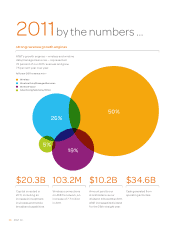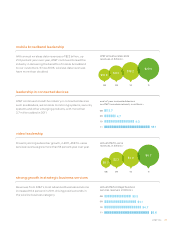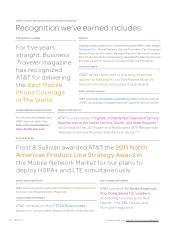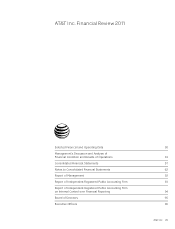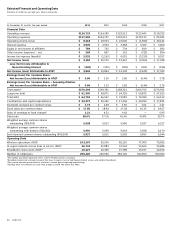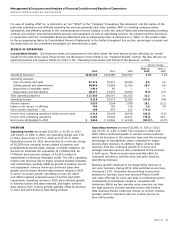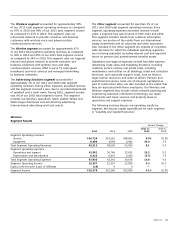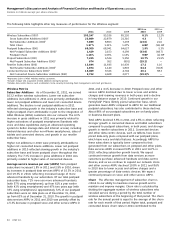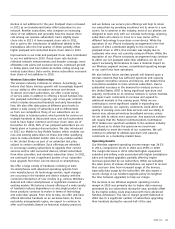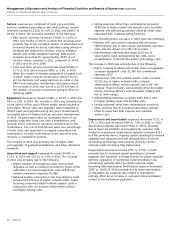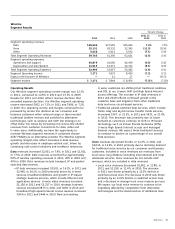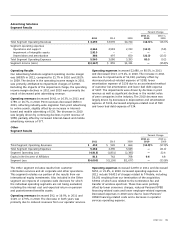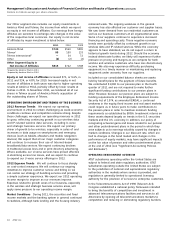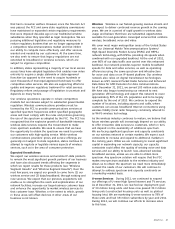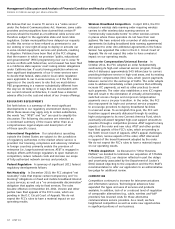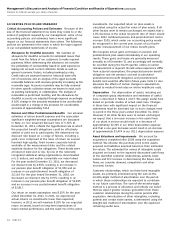AT&T Wireless 2011 Annual Report Download - page 37
Download and view the complete annual report
Please find page 37 of the 2011 AT&T Wireless annual report below. You can navigate through the pages in the report by either clicking on the pages listed below, or by using the keyword search tool below to find specific information within the annual report.
AT&T Inc. 35
and we believe our service plan offerings will help to retain
our subscribers by providing incentives not to move to a new
carrier. As is common in the industry, most of our phones are
designed to work only with our wireless technology, requiring
subscribers who desire to move to a new carrier with a
different technology to purchase a new device. While the
expiration of our iPhone exclusivity arrangement in the first
quarter of 2011 contributed slightly to the increase in
postpaid churn in 2011, this increase was largely due to
customers who were not currently using an iPhone. While the
expiration of our iPhone exclusivity arrangement may continue
to affect our net postpaid subscriber additions, we do not
expect exclusivity terminations to have a material impact on
our Wireless segment income, consolidated operating margin
or our cash flows from operations.
We also believe future wireless growth will depend upon a
wireless network that has sufficient spectrum and capacity
to support innovative services and devices, and makes these
innovations available to more wireless subscribers. Due to
substantial increases in the demand for wireless service in
the United States, AT&T is facing significant spectrum and
capacity constraints on its wireless network in certain markets.
We expect such constraints to increase and expand to
additional markets in the coming years. While we are
continuing to invest significant capital in expanding our
network capacity, our capacity constraints could affect the
quality of existing voice and data services and our ability to
launch new, advanced wireless broadband services, unless
we are able to obtain more spectrum. Any spectrum solution
will require that the Federal Communications Commission
(FCC) makes new spectrum available to the wireless industry
and allows us to obtain the spectrum we need more
immediately to meet the needs of our customers. We will
continue to attempt to address spectrum and capacity
constraints on a market-by-market basis.
Operating Results
Our Wireless segment operating income margin was 24.2%
in 2011, compared to 26.1% in 2010 and 25.8% in 2009.
The margin decrease in 2011 reflected higher equipment
subsidies and selling costs associated with higher smartphone
sales and handset upgrades, partially offset by higher
revenues generated by our subscribers. While we subsidize
the sales prices of various smartphones, we expect to recover
that cost over time from increased usage of the devices,
especially data usage by the subscriber. We also expect a
recent change in our handset upgrade policy (to lengthen
the time between upgrades) to help our margin.
The increase in our Wireless segment operating income
margin in 2010 was primarily due to higher data revenues
generated by our subscribers during the year, partially offset
by the higher selling costs associated with more advanced
handset activations. The rate of margin growth flattened in
2010 due to a significant number of subscribers upgrading
their handsets during the second half of the year.
decline in net additions for the year. Postpaid churn increased
in 2011 as we transitioned former Alltel subscribers to our
network. Reseller subscribers, who comprise an increasing
share of net additions and generally have the lowest churn
rate among our wireless subscribers, had a slightly lower
churn rate in 2011. A lower prepaid churn rate in 2011,
due in part to the introduction of additional tablets to the
marketplace after the first quarter of 2010, partially offset
higher postpaid and connected device churn rates in 2011.
Improvement in our total and postpaid churn rates contributed
to our net additions in 2010. These churn rate declines
reflected network enhancements and broader coverage, more
affordable rate plans and exclusive devices, continued growth
in family plans, and free mobile-to-mobile calling among our
wireless subscribers. Data-centric device subscribers increased
their share of net additions in 2010.
Wireless Subscriber Relationships
The wireless industry continues to mature. Accordingly, we
believe that future wireless growth will increasingly depend
on our ability to offer innovative services and devices.
To attract and retain subscribers, we offer a wide variety
of service plans in addition to offering a broad handset line.
Our postpaid subscribers typically sign a two-year contract,
which includes discounted handsets and early termination
fees. We also offer data plans at different price levels to
attract a wide variety of subscribers and to differentiate
us from our competitors. Many of our subscribers are on
family plans or business plans, which provide for service on
multiple handsets at discounted rates, and such subscribers
tend to have higher retention and lower churn rates. As of
December 31, 2011, 86% of our postpaid subscribers are on
family plans or business discount plans. We also introduced
in 2011 our Mobile to Any Mobile feature, which enables our
new and existing subscribers on these and other qualifying
plans to make unlimited mobile calls to any mobile number
in the United States as part of an unlimited text plan,
subject to certain conditions. Such offerings are intended
to encourage existing subscribers to upgrade their current
services and/or add connected devices, attract subscribers
from other providers, and minimize subscriber churn. In 2011,
we continued to see a significant portion of our subscriber
base upgrade from their current devices to smartphones.
We offer a large variety of handsets, including at least
16 smartphones with advanced operating systems from
nine manufacturers. As technology evolves, rapid changes
are occurring in the handset and device industry with the
continual introduction of new models (e.g., various Windows,
Android and other smartphones) or significant revisions of
existing models. We believe a broad offering of a wide variety
of handsets reduces dependence on any single product as
these products continue to evolve in terms of technology
and subscriber appeal. From time to time, we offer and have
offered attractive handsets on an exclusive basis. As these
exclusivity arrangements expire, we expect to continue to
offer such handsets (based on historical industry practice),



